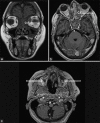Spectrum of magnetic resonance imaging findings in post-COVID-19 patients presenting with rhino-orbito-cerebral mucormycosis in a teaching hospital in Malwa region of Punjab
- PMID: 36994047
- PMCID: PMC10041016
- DOI: 10.4103/jfmpc.jfmpc_1136_22
Spectrum of magnetic resonance imaging findings in post-COVID-19 patients presenting with rhino-orbito-cerebral mucormycosis in a teaching hospital in Malwa region of Punjab
Abstract
Background: Rhino-orbito-cerebral-mucormycosis (ROCM) associated with COVID-19 infection was at its peak during and immediately after the second wave of the pandemic in India during 2021. Many of the risk factors were implicated in the development of this deadly fungal infection, when there was a sudden surge of cases, especially who had a history of COVID-19 infection.
Objectives: The objective of the study was to describe the characteristic magnetic resonance imaging (MRI) findings in invasive mucormycosis and to evaluate the extent and severity of invasive mucormycosis.
Materials and methods: A retrospective study was carried out for 4 months which included 60 patients who underwent MRI using a Siemens Avanto 1.5 Tesla scanner. During our study, 68 cases were selected based on clinicoradiological features suspected of ROCM. However, 8 patients were excluded on the basis of exclusion criteria as either there was no definitive evidence of COVID infection or were proven to be negative for mucormycosis on microbiological examination.
Results: On the basis of the spectrum of MRI findings, post-COVID-19 related ROCM was broadly categorized into three stages. Out of total of 60 patients, the disease was localized to the nasal and paranasal sinus region (Stage I) in 7 patients (11.66%), extending to adjacent extrasinus orofacial soft tissue structures (Stage II) in 36 patients (60%), and intracranial extension of disease (Stage III) was seen in 17 patients (28.33%).
Conclusion: In post-COVID-19 patients presenting with clinical features suspected of ROCM, MRI imaging helps in early diagnosis and staging/severity of ROCM, so that timely intervention can be planned to reduce mortality as well as morbidity.
Keywords: Black turbinate sign; COVID-19; ROCM; mucormycosis; orbital cellulitis.
Copyright: © 2023 Journal of Family Medicine and Primary Care.
Conflict of interest statement
There are no conflicts of interest.
Figures







Similar articles
-
Radiological Manifestations of Rhino-Orbito-Cranial Mucormycosis in COVID-19 Patients Correlated With Pathological and Clinical Outcomes and Emphasis on Magnetic Resonance Imaging-Based Scoring System.Cureus. 2023 Mar 3;15(3):e35745. doi: 10.7759/cureus.35745. eCollection 2023 Mar. Cureus. 2023. PMID: 37020477 Free PMC article.
-
Magnetic Resonance Imaging Features of Rhino-Orbito-Cerebral Mucormycosis in Post-COVID-19 Patients: Radio-Pathological Correlation.Diagnostics (Basel). 2023 Apr 25;13(9):1546. doi: 10.3390/diagnostics13091546. Diagnostics (Basel). 2023. PMID: 37174937 Free PMC article.
-
Magnetic Resonance Imaging in Coronavirus Disease - 2019 Associated Rhino-Orbital-Cerebral Mucormycosis (CA-ROCM) - Imaging Analysis of 50 Consecutive Patients.Curr Probl Diagn Radiol. 2022 Jan-Feb;51(1):112-120. doi: 10.1067/j.cpradiol.2021.09.004. Epub 2021 Nov 3. Curr Probl Diagn Radiol. 2022. PMID: 34802841 Free PMC article. Review.
-
A fungal epidemic amidst a viral pandemic: Risk factors for development of COVID-19 associated rhino-orbital-cerebral mucormycosis in India.Orbit. 2023 Feb;42(1):30-41. doi: 10.1080/01676830.2021.2020851. Epub 2022 Feb 22. Orbit. 2023. PMID: 35192435
-
COVID-19-associated rhino-orbital-cerebral mucormycosis: A systematic review, meta-analysis, and meta-regression analysis.Indian J Pharmacol. 2021 Nov-Dec;53(6):499-510. doi: 10.4103/ijp.ijp_839_21. Indian J Pharmacol. 2021. PMID: 34975140 Free PMC article.
References
LinkOut - more resources
Full Text Sources
